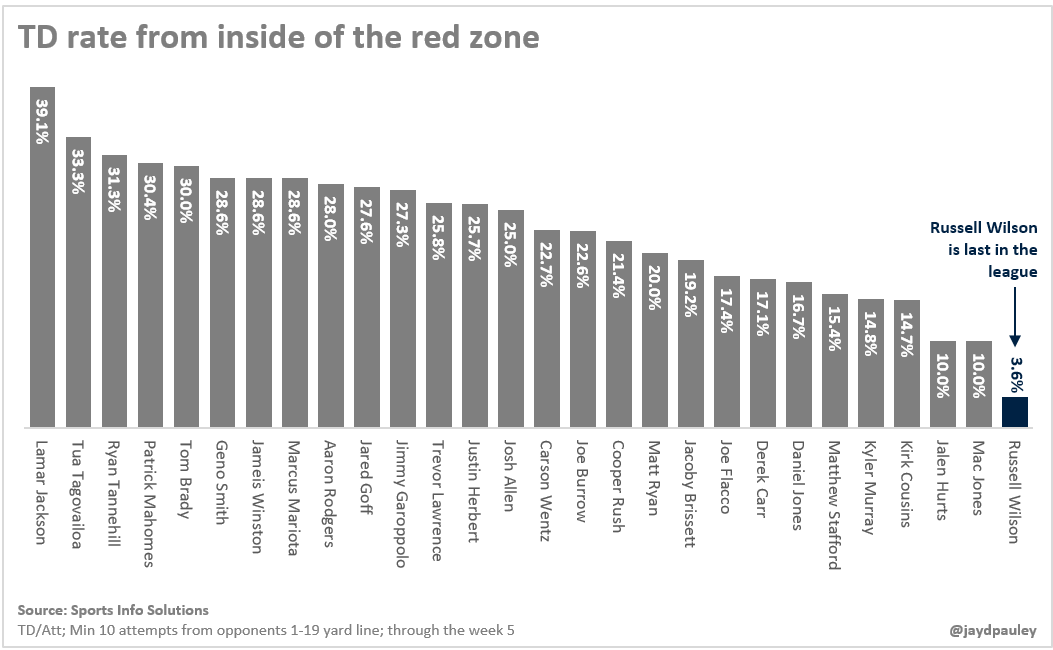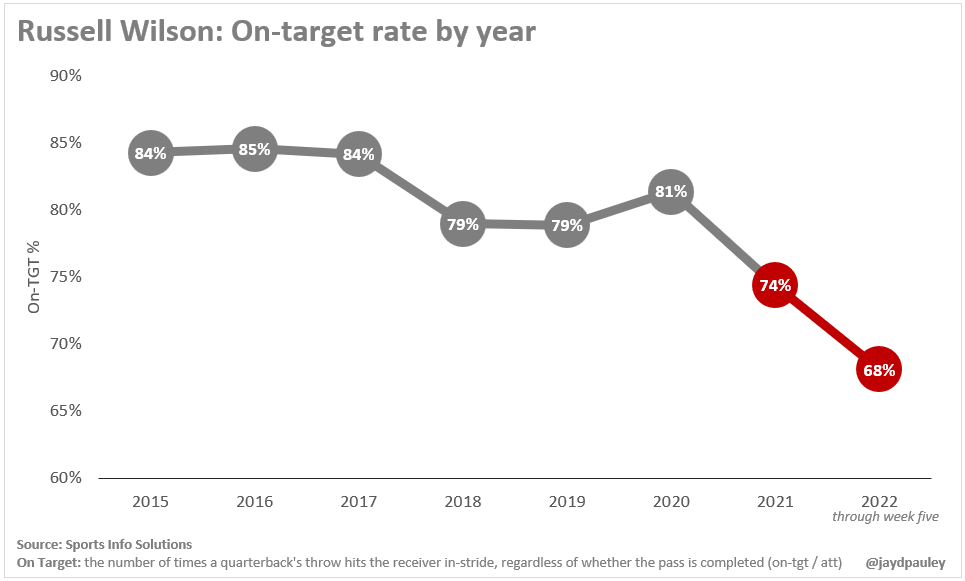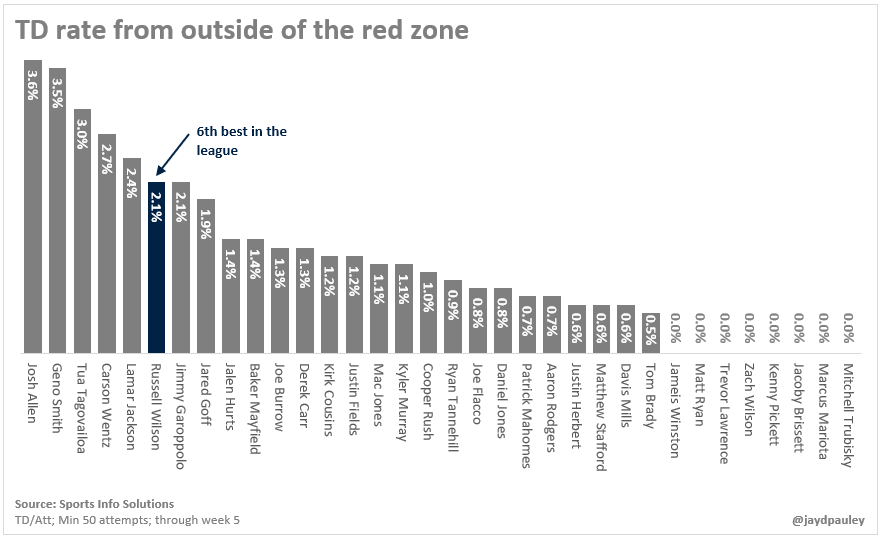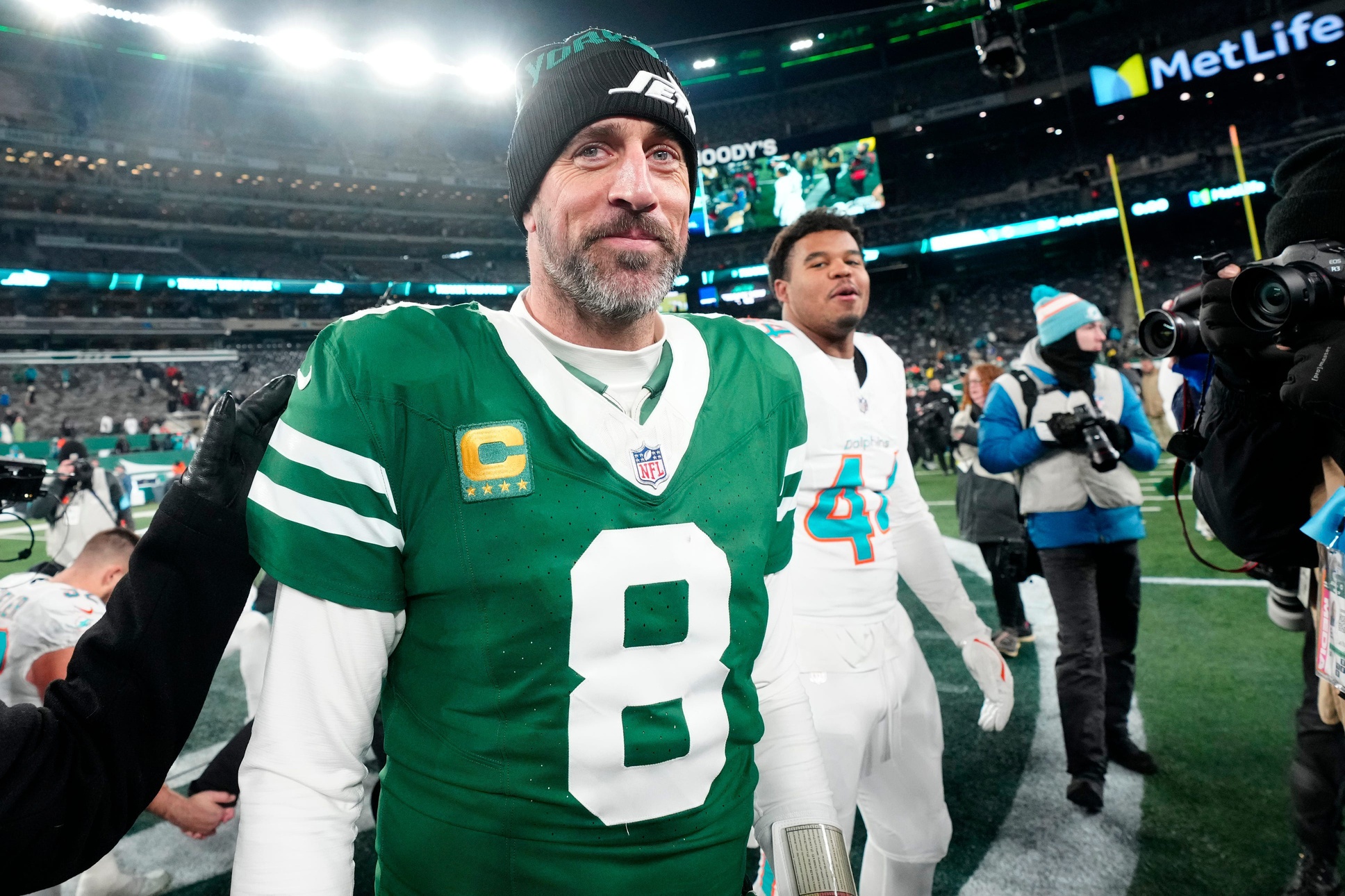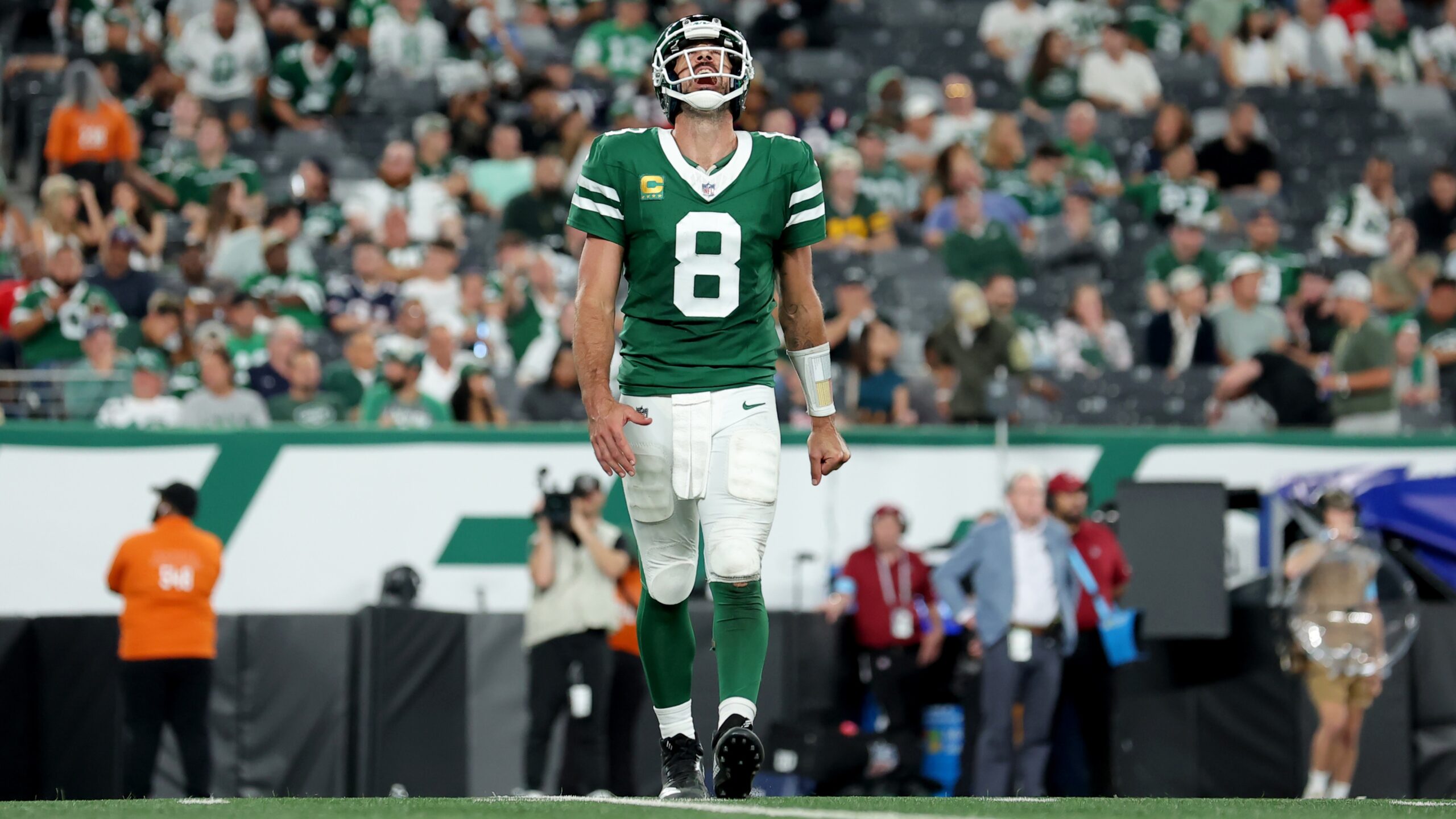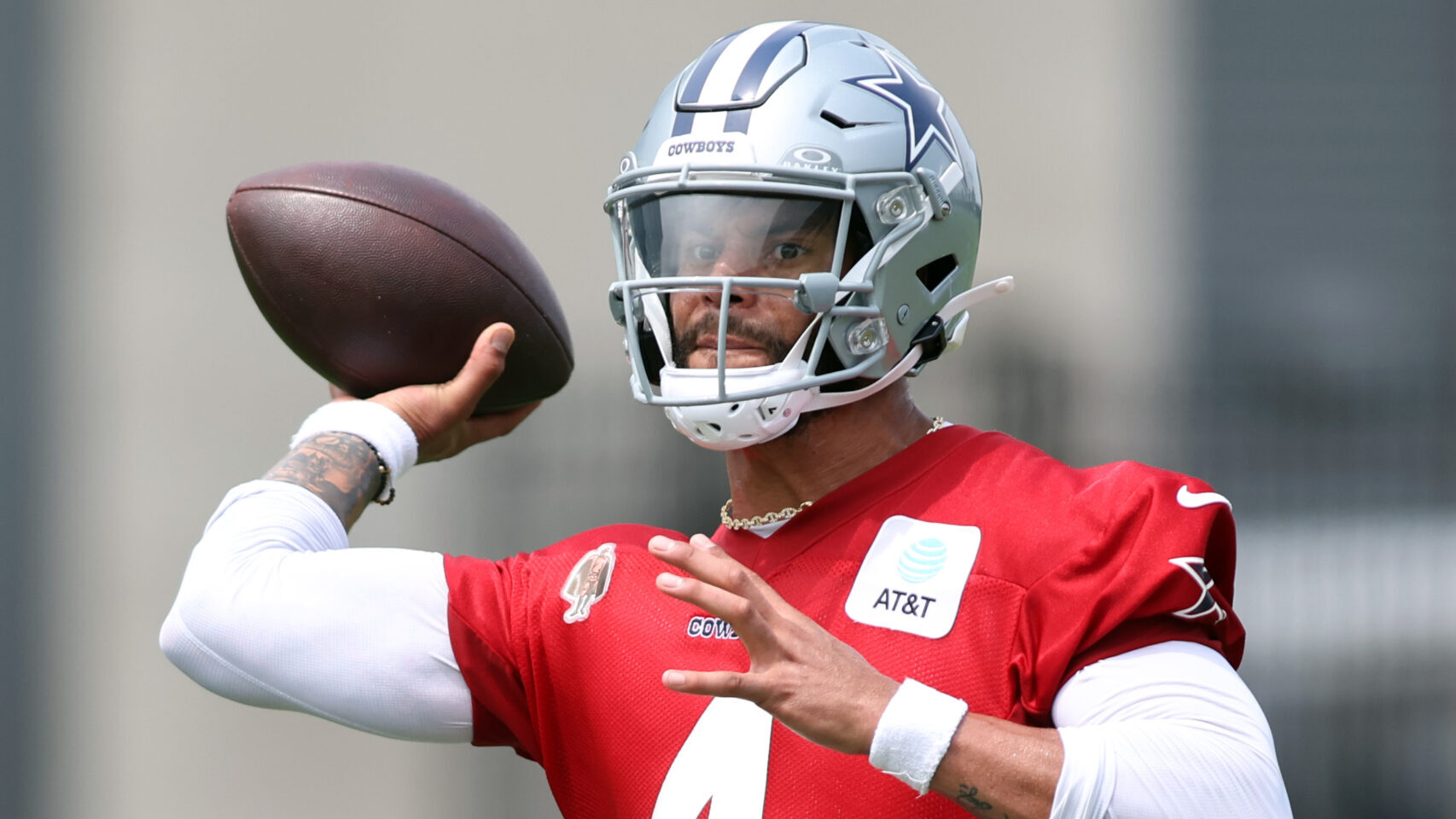Analysis
10/13/22
8 min read
Key Metrics Behind Russell Wilson’s Difficult Season

By now, you've surely seen the final play of the Broncos-Colts Thursday night game over and over again. Russell Wilson never saw receiver K.J. Hamler, who was wide open for the game-winning touchdown. Instead, Wilson was locked in on a well-covered Courtland Sutton and forced a pass that fell incomplete for the final play.
Game over. The Colts won 12-9 in a game where every point came from a field goal. Hamler, as he told NFL Network's James Palmer after the game, "could have walked in.”
[bc_video video_id="6313437977112" account_id="6312875271001" player_id="default" embed="in-page" padding_top="56%" autoplay="" min_width="0px" playsinline="playsinline" picture_in_picture="" language_detection="" max_width="640px" mute="" width="100%" height="100%" aspect_ratio="16:9" sizing="responsive" ]
With the addition of Wilson and up-and-coming head coach Nathaniel Hackett, the Broncos' 2-3 start and 14.6 offensive points per game have been an unmitigated disaster so far. Wilson has been front and center of many of the problems in Denver. Through five games, Wilson is ranked 20th in the NFL in passer rating at 82.8. For context, last year’s starting QB for the Broncos, Teddy Bridgewater, ended up with a passer rating of 94.9, the 12th best in the league.
This would be Wilson’s worst passer rating ever, and it’s not even close.
His career rating is 101; his worst season before this year was 2016, with a 92.6. He is currently 10-points below his worst season ever. This is troubling for the Broncos, who just signed Wilson to a five-year extension through the 2028 season with the second-highest average annual contract value in the league at $49 million per year.
Aside from standard statistics like passer rating, completion percentage and volume stats, we explored the insights and data provided by the Sports Info Solutions data hub to find areas where Wilson is having trouble. We also look at a couple of things he's doing well.
Key areas where Wilson is struggling:
Red zone Touchdown Rate
Wilson has thrown a touchdown on only 2.4% of his passes. For qualifying quarterbacks, he’s ranked 29th in the league, with only Mitch Trubisky, Daniel Jones and Mac Jones ranking lower. This is almost four points lower than his 6.3 rate last season and much lower than his career rate of 6.0.
On its own, touchdown rate lacks the nuance needed to be an extremely valuable metric, but directionally it can signal issues. In this case, those issues are inside the red zone. Across the league, nearly 23% of red zone pass attempts end in a touchdown, but inside the 20-yard line, Wilson has a meager rate of 3.6%, which is dead last in the league. His struggles are a reason why the Broncos have a 21% touchdown rate in the red zone, the worst in the NFL and down from 55% last season.
On-Target Rate
SIS defines on-target passes as the number of times a quarterback's throw hits the receiver in-stride, regardless of whether the pass is completed.
Wilson's 68% on-target percentage ranks 27th out of 32 qualified quarterbacks. The median among qualifying quarterbacks for this statistic is about 74%. Wilson is trending down in this category for the second straight season. He went from 81% in 2020, to 74% in 2021, to 68% in 2022. Before this season, 81% of his throws were on target from 2015-2021. This is a concerning decline indicative of a more significant ongoing problem.
IQR (Independent Quarterback Rating)
We mentioned Wilson’s passer rating of 82.8, but his rating is even worse when adjusted by the IQR metric. IQR is SIS’ proprietary quarterback metric that builds on the traditional Passer Rating formula by considering the value of a quarterback independent of results outside of his control, such as dropped passes, dropped interceptions, throwaways, etc.
Wilson has an IQR of 77.9, which ranks 28th. His IQR is 4.9 points lower than his passer rating, suggesting even his poor passer rating of 82.8 is inflated by factors outside of his control, aka luck. The -4.9 difference between his passer rating and IQR is the second-largest negative gap in the league.
The unluckiest quarterback, as defined by the difference between IQR and passer rating is Daniel Jones, with a passer rating of 85.7 and an IQR of 95.9. The luckiest quarterback so far is Mac Jones, with a 76.2 passer rating and a 70.9 IQR.
Positive % and Expected Points Added (EPA)
SIS defines positive play % as the percentage of passes thrown by the player that resulted in a positive EPA (i.e., a successful play for the offense).
When Wilson throws the ball, he improves his team's expected points only 38% of the time. The positive percentage metric is based on the difference between the teams’ expected points before the play compared to their expected points after the play when Wilson throws a pass (Expected Points Added).
The median positive play percentage among the qualifying quarterbacks is 45%. The only quarterbacks worse than Wilson through Week 5 are Joe Flacco, Davis Mills, Trubisky, Baker Mayfield and Justin Fields. Wilson’s rate drops considerably to 28% when he’s inside the red zone.
Since 2015, Wilson has never dropped below 42%, and he was 47% for his career before this season. His EPA is -20.9 through five games. When Wilson passes the ball, the Broncos' situation has worsened by an aggregate of 21 expected points. For context, the league leader is Josh Allen with +45.1, and the worst is Mayfield with -40.0. Wilson ranks 23rd out of 32 qualifying quarterbacks and is on pace to have a second consecutive season with negative EPA.
What Wilson is doing well
Touchdown Rate
How can Wilson’s touchdown rate be both good and bad? Well, he's efficient and excels from his team’s one-yard line to his opponent's 20-yard line. When not in the red zone, Wilson has a touchdown rate of 2.1%. This is the sixth-best rate out of 34 quarterbacks with at least 50 attempts outside the red zone.
The NFL's average touchdown rate from outside the red zone is 1.2%. Wilson has nearly doubled that rate so far. League-wide, 75% of passing touchdowns have come from inside the red zone and 25% from outside of the red zone. However, Wilson is the opposite, with only 25% (one passing TD) from inside the red zone and 75% (three passing TDs) outside the red zone. Wilson's three touchdown passes from outside the red zone have him tied for the third most in the NFL.
Average Throw Depth
Wilson can’t be accused of constantly checking down and dumping off short passes. His average throw is 8.5 yards, ninth highest in the league. While it’s a full yard shy of his average last year, it’s in line with what he has done throughout his career.
He has thrown the second most passes (26) for more than 20 yards. Carson Wentz is 1st with 27. On those 26 pass attempts, Wilson has a reasonably average completion %, on-target rate, passer rating and IQR. He has also thrown for two touchdowns, a solid TD percentage of 7.7% and +11.4 expected points added, which is sixth best on passes of 20+ yards.
Interceptions
With two very costly interceptions against the Colts, recency bias could make people disagree with the claim Wilson is doing well here. However, bad games happen, and this one occurred with 10 million people watching while the Broncos-Colts were the only game on TV.
Recency bias aside, until Week 5, Wilson had avoided interceptions well. He had one interception on 131 attempts (0.8%) through game four. The league average interception rate since Wilson's rookie season has been about 2.5%.
This year it’s 2.3%, and Wilson is sitting at 1.8%, a rate consistent with his career numbers. While his 1.8% isn’t one of the best rates in the league (12th best), it’s still better than average. It's one of the few metrics where he hasn’t seen a significant adverse change from his previous seasons. He has never been interception prone, and his ball protection has continued this year, despite his two critical picks on Thursday night.
There may not be many surprises in the key metrics we identified. The most impactful metric so far is Wilson’s failure to produce in the red zone. This could turn around with a couple of good performances influencing his small number of attempts (28).
However, his 68% on-target rate across 170 pass attempts is more concerning. He hit a career-low last year and is on pace to set a second consecutive career-low again. Until Wilson can improve his accuracy, Denver pass-catchers Courtland Sutton, Javonte Williams and Jerry Jeudy will have to lift the Broncos catch rate of 61.6% (Rec/Tgts) out of the league's bottom seven.
Wilson is having a bad stretch. It’s not like he hasn’t had these stretches before. You can see for yourself by pouring over Wilson’s career game logs on Pro Football Reference. But this time, Wilson's poor play is paired with the expectations of signing a massive contract with a team trying to compete for a Super Bowl in the NFL's toughest division.
In the past, his bad stretches have been blips that faded into the background as he continued playing like a top-tier quarterback each year, but at some point, the blip won’t be a blip. It will be the beginning of the end. That may not be the case yet, but it will be interesting to see how these key trouble areas play out for the remainder of the season.
Watch More: Leonard Fournette Breaks Down Viral Block on Micah Parsons
[bc_video video_id="6313672242112" account_id="6312875271001" player_id="default" embed="in-page" padding_top="56%" autoplay="" min_width="0px" playsinline="playsinline" picture_in_picture="" language_detection="" max_width="640px" mute="" width="100%" height="100%" aspect_ratio="16:9" sizing="responsive" ]

